What does it mean for a sewing machine to be out of time?
Understanding this concept is important because if your sewing machine is out of time, then you’ll likely need to take it to a trained sewing machine technician for a fix. On the other hand, if your machine is not out of time, then the problem lies elsewhere and fixing the problem may be in your control.
When we refer to timing, we are referring to the timing between the machine’s upper shaft and the machine’s lower shaft. The upper shaft and lower shaft must operate in harmony together, for each controls the movement of critical components to the stitch-making process.
The upper shaft controls the movement of the needle bar, and therefore the movement of the needle.
The lower shaft controls the movement of the hook and the feed dogs.



Given that proper sewing machine operation depends on the needle bar being synced up to both the hook mechanism and feed dogs, there are two different types of timing:
Needle-Hook Timing: the precise timing between the movement of the needle and the hook.
Needle-Feed Timing: the precise timing between the movement of the needle and the feed dogs.
Needle-Hook Timing
A useful way to think of needle-hook timing is to consider the movement of the needle and hook individually, then consider their relationship to each other as it pertains to the stitch-making process.
The Hook
The hook rotates around the bobbin and bobbin case (no matter if your machine is designed with a rotary hook or oscillating hook).
For oscillating hook machines, the hook-point rotates back and forth on a vertical axis, rotating clockwise and then counter-clockwise.
For rotary hook machines, the hook-point continuously rotates counter-clockwise on a horizontal or vertical axis.
The Needle
The needle starts in its highest position, several centimeters above the needle plate.
As the machine begins the stitch-making process, the needle travels downward, down below the needle plate, until it reaches its bottommost position.
Once it hits its bottommost position, the needle travels upward, up above the needle plate, until it reaches its highest position again.
The needle’s revolution (upper shaft) and the hook’s revolution (lower shaft) are TIMED so that the hook passes behind the needle at a very specific point in time: when the needle rises 2-3 millimeters above its bottommost position, the HOOK POINT should pass right above the NEEDLE’S EYE.
Why?
Because, as the needle rises upward, a tiny thread loop forms at the eye of the needle (on the backside of the needle). If the machine is correctly timed, the hook-point passes just above the eye of the needle and passes through the tiny thread loop right after that loop has formed.
The hook catches the needle thread loop and then takes the needle thread with it for a ride as it completes its revolution around the bobbin case. As the hook completes its revolution, a knot forms between the needle thread and bobbin thread, a crucial step in the stitch-making process.
What does it look like for needle-hook timing to be off?
Remove your needle plate and bobbin case. Turn the machine’s hand wheel (turn it toward you) until the needle reaches its lowest position. Continue to turn the hand wheel slowly so that you can clearly see the needle begin to rise upward . As the needle begins its upward trajectory, the hook will pass behind the needle. On what point of the needle is the hook passing?
Remember, we want the hook to pass just above the eye of the needle after the needle has risen 2-3 millimeters above its bottommost position. It is possible for the timing to be off in either direction— the timing could be advanced, or it could be retarded.
If the needle-hook timing is advanced, that means the hook is arriving at the needle earlier than it ought to. It still passes above the eye of the needle, but passes too high and fails to catch the needle’s thread loop.
If the needle-hook timing is retarded, that means the hook is arriving at the needle later/slower than it ought to. It passes below the eye of the needle and therefore misses its chance to catch the needle’s thread loop.
Needle-Feed Timing
Similar to hook timing, a useful way to think of feed timing is to consider the relationship between the needle and the feed dogs.
The Needle
The needle starts in its highest position, several centimeters above the needle plate.
As the machine begins the stitch-making process, the needle travels downward, down below the needle plate, until it reaches its bottommost position.
Once it hits its bottommost position, the needle travels upward, up above the needle plate, until it reaches its highest position again.
The Feed Dogs
The feed dogs begin above the needle plate, with the gripped feed teeth making contact with the bottom layer of fabric.
As the needle enters the fabric, the feed dogs drop beneath the needle plate, so that they no longer make contact with the fabric.
As the needle rises back up above the needle plate, the feed dogs also rise (again making contact with the fabric).
After rising above the needle plate, the feed dogs move from the front of the needle plate to the back of the needle plate, moving the specific distance that you have set your stitch length (typically 2-4 millimeters).
The movement of the needle is timed with the movement of the feed dogs so that the feed dogs lower beneath the needle plate while the needle is penetrating the fabric. If feed timing is correct, then the feed dogs will only rise back up above the needle plate and feed the fabric after the needle has rise out of the fabric.
In other words, the feed dogs only feed the fabric after the machine has made a stitch. This means the feed dogs are inactive during the stitch-making process while the needle is down below the needle plate, and active when the needle has risen up above the needle plate.
What does it look like for needle-feed timing to be off?
Proper needle-feed timing looks like this:
As the needle enters the needle plate hole, the feed dogs should be going down beneath the needle plate.
They should no longer be above the needle plate feeding the fabric forward.
Then, as the needle rises up out of the needle plate, the feed dogs should begin to rise out of the needle plate as well.
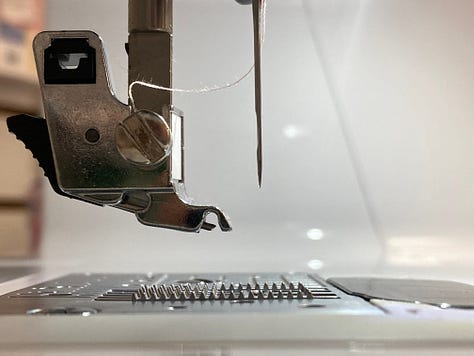

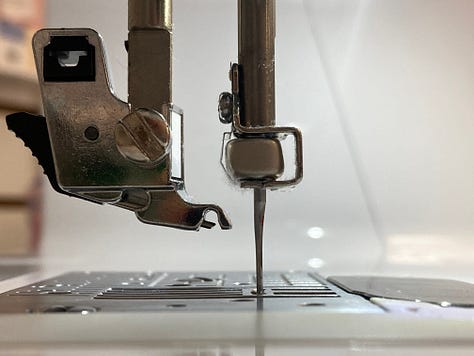
If needle-feed timing is off, that means that the feed dogs are feeding the fabric during the stitch-making process. Or, in other words, the fabric is being fed while the needle is still in the fabric.
If the needle is down below the needle plate, but the feed dogs are up above the needle plate and feeding the fabric forward, then the feed timing is off.
If the needle is up above the needle plate, but the feed dogs are not rising above the needle plate until the needle is getting close to re-entering the fabric, then it is also possible that the feed timing is out of whack.
We don’t want the fabric being fed while the needle is in the fabric for a few different reasons. One, if the needle is deep in the fabric while fabric is being fed, then the needle will bend and/or break, potentially causing harmful needle strikes to key areas like the hook, needle plate, and bobbin case. Two, even if the feed timing is slightly off, stitch quality can be negatively affected because the action of the feed dogs feeding the fabric helps cinch the knot properly in the fabric.
What causes a sewing machine to go out of time?
I’d guess that the most common reason a machine goes out of time is when we try to sew through something too thick for my machine to handle.
Imagine, I try to sew through thick leather on a small home sewing machine. My needle (upper shaft) gets stuck in the material and stops moving, but the hook and/or feed dogs (lower shaft) continues to turn.
Incongruity between the upper shaft and lower shaft—even for a split second— can cause the machine to go out of time.
Can you fix a timing issue yourself?
The short answer is no, probably not.
To fix a machine that is out of time, you have to remove the machine’s plastic cover and expose the internal components. Then you have to disengage the machine’s lower shaft from the upper shaft and manually time the hook mechanism and feed dog mechanism to the needle position. The sequence in which you perform these tasks matter. The timing must be very precise. Sewing machine companies actually make tools and gauges specific to certain machine models to help the technician time the machine properly.
That’s all to say, if your machine is out of time, I recommend you take the machine to a trained sewing machine technician.
If you found this article helpful, please feel free to share with fellow sewing machine enthusiasts!
Thank you for reading,
-Cale

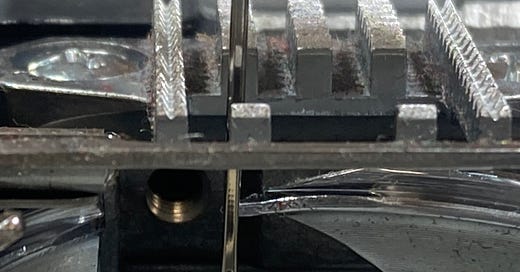


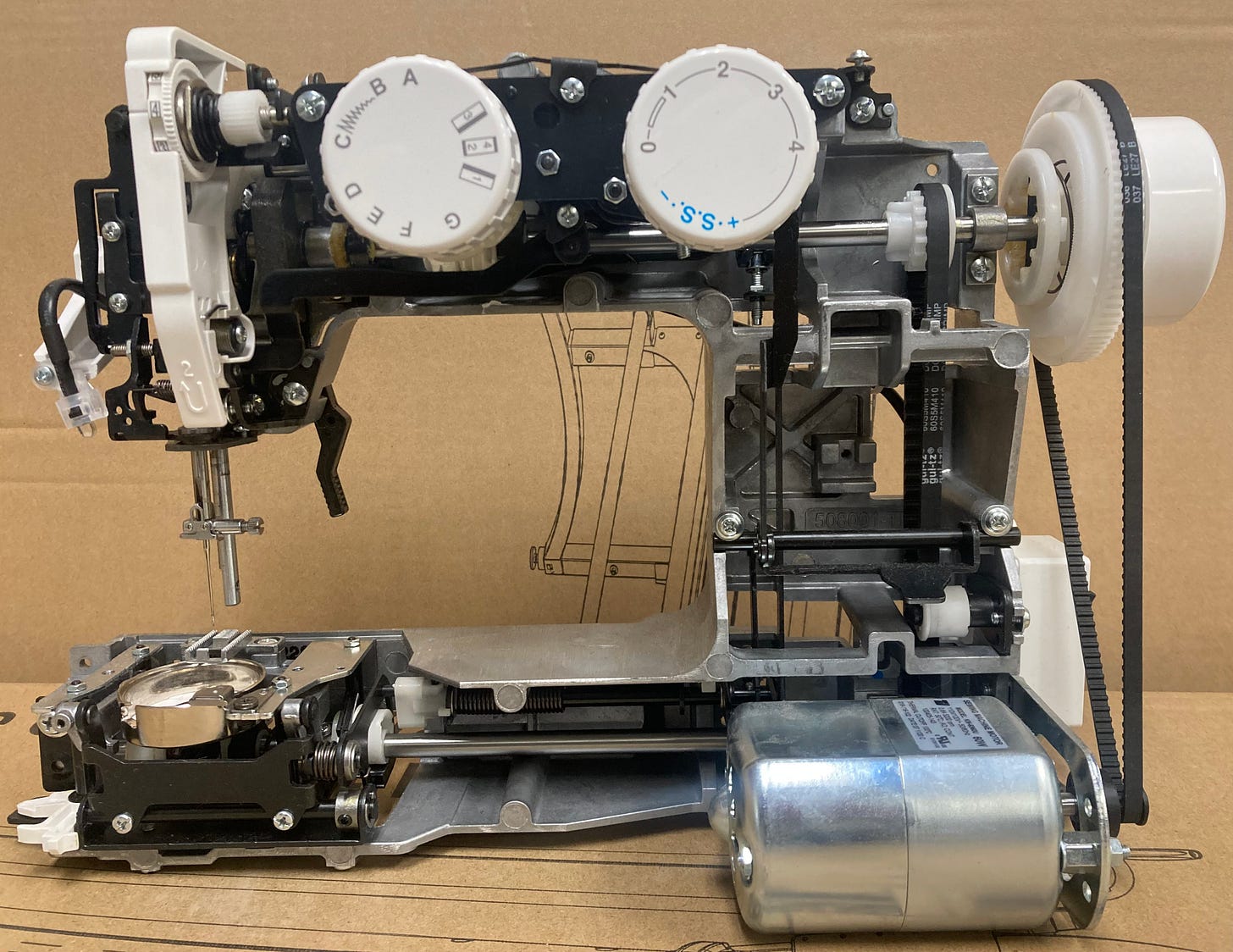


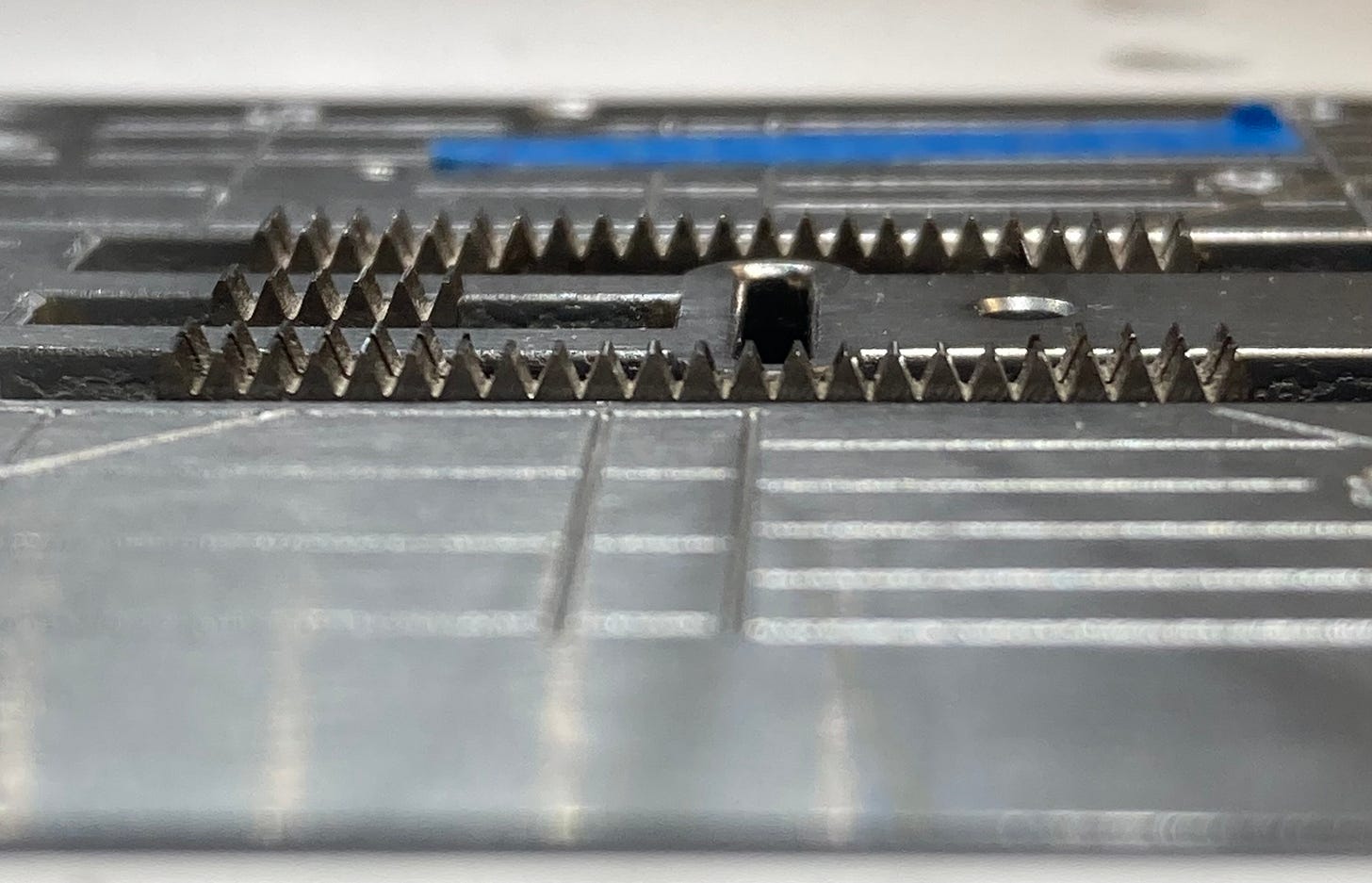
I so enjoy your articles...easy to understand, they make my sewing life better!